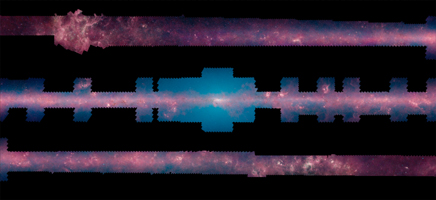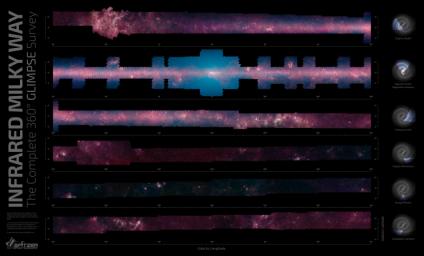
Figure 1
Click on the image for larger versionWhen you look up at the Milky Way on a clear, dark night, you'll see a band of bright stars arching overhead. This is the plane of our flat spiral galaxy, within which our solar system lies.
A new, zoomable panorama from NASA's Spitzer Space Telescope shows us our galaxy's plane all the way around us in infrared light. The 360-degree mosaic comes primarily from the GLIMPSE360 project, which stands for Galactic Legacy Infrared Mid-Plane Survey Extraordinaire. It consists of more than 2 million snapshots taken in infrared light over 10 years, beginning in 2003 when Spitzer launched.
The Milky Way diagrams to the right of the panels show what slice of the galaxy is being seen. The center of the galaxy was the most widely covered and is shown in the second row. The outer regions of our galaxy, away from its bustling center, are in the last three rows.
This infrared view reveals much more of the galaxy than can be seen in visible-light views. Whereas visible light is blocked by dust, infrared light from stars and other objects can travel through dust to reach Spitzer's detectors. For instance, when looking up at our night skies, we see stars that are an average of 1,000 light-years away; the rest are hidden. In Spitzer's mosaic, light from stars throughout the galaxy -- which stretches 100,000 light-years across -- shines through. This picture covers only about three percent of the sky, but includes more than half of the galaxy's stars and the majority of its star formation activity.
The red color shows dusty areas of star formation. Throughout the galaxy, tendrils, bubbles and sculpted dust structures are apparent. These are the results of massive stars blasting out winds and radiation. Stellar clusters deeply embedded in gas and dust, green jets and other features related to the formation of young stars can also be seen for the first time. Looking toward the galactic center, the blue haze is made up of starlight -- the region is too far away for us to pick out individual stars, but they contribute to the glow. Dark filaments that show up in stark contrast to the bright background are areas of thick, cold dust that not even infrared light can penetrate. If you look closely, it's even possible to spot distant galaxies that lie far beyond the Milky Way.
Scientists are using these images to get to know our galaxy better. They've come up with better maps of its central bar of stars and spiral structure, discovered new remote sites of star formation and even come across new mysteries; for example, the dust grains indicate a higher abundance of carbon in the galaxy than expected. The GLIMPSE360 map will guide astronomers for generations, helping them to further chart the unexplored territories of our own Milky Way.
The image combines data from multiple surveys in addition to GLIMPSE360: GLIMPSE, GLIMPSEII, GLIMPSE3D, Vela-Carina, Deep GLIMPSE, CYGX, GALCEN and SMOG. Twelve-micron data from NASA's Wide-field Infrared Survey Explorer (WISE) was substituted for missing 8-micron data in outer galaxy regions mapped during Spitzer's post-cryogen mission.
Zoomable, full-resolution and poster versions of the image are online at http://www.spitzer.caltech.edu/glimpse360.
NASA's Jet Propulsion Laboratory, Pasadena, Calif., manages the Spitzer Space Telescope mission for NASA's Science Mission Directorate, Washington. Science operations are conducted at the Spitzer Science Center at the California Institute of Technology in Pasadena. Spacecraft operations are based at Lockheed Martin Space Systems Company, Littleton, Colorado. Data are archived at the Infrared Science Archive housed at the Infrared Processing and Analysis Center at Caltech. Caltech manages JPL for NASA.
For more information about Spitzer, visit http://spitzer.caltech.edu and http://www.nasa.gov/spitzer.

 Planetary Data System
Planetary Data System













